4.2 Volcano Shape
Charlene Estrada
Types of Volcanoes
There are all types of volcanoes on our planet: some are huge, some are no bigger than hills, some are explosive, and some are less so. There are several broad types of volcanoes based on their shape, eruption style, magma composition, and other aspects. However, all volcanoes should be regarded as potentially deadly!
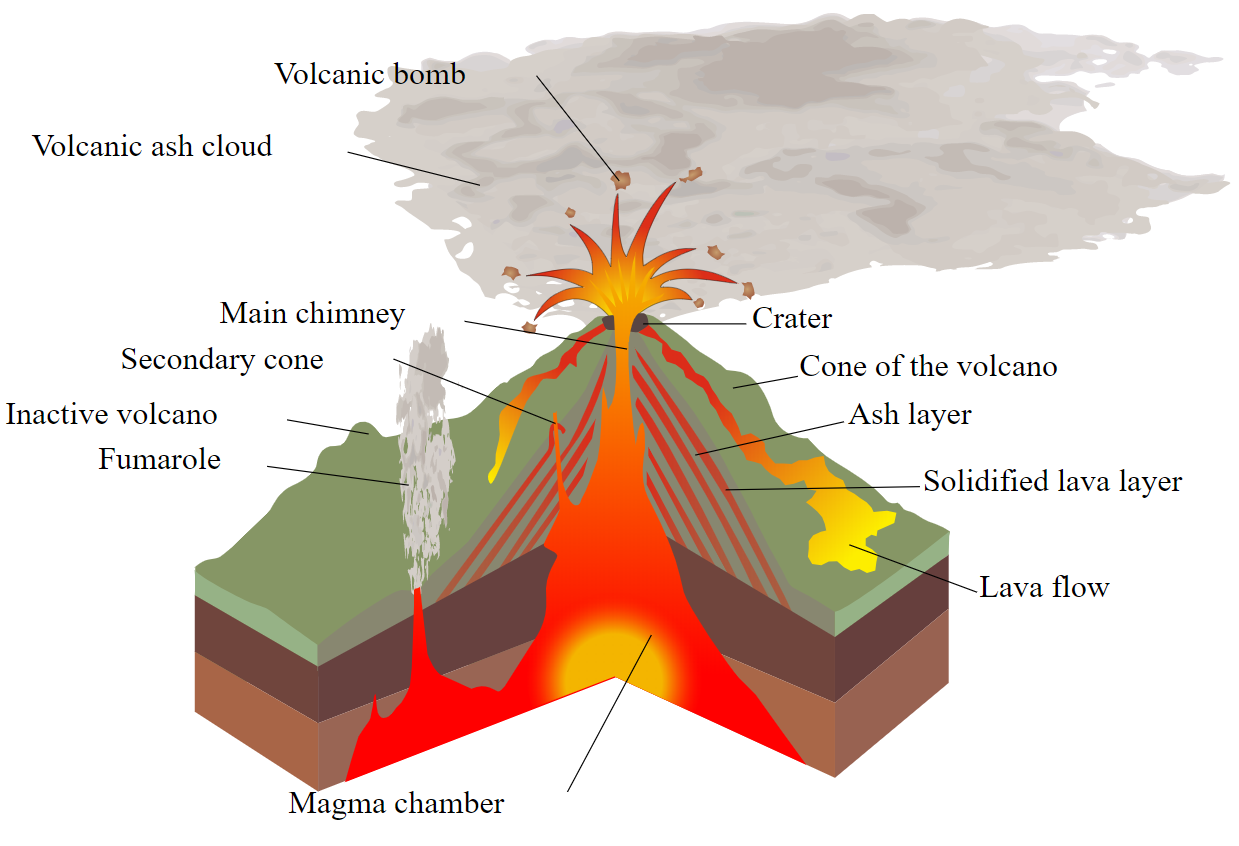
Volcanoes have a cone-shaped structure that has been built over long periods of geologic time after multiple eruptions. At the very top of this cone is a crater. All active volcanoes sit atop a plume of magma called a magma chamber. The composition of this magma can vary from felsic to mafic depending on factors such as region, overlying crust composition, and tectonic setting.
When the magma chamber experiences too much pressure, it will erupt. The molten rock and volatile gases explode upward through a pipe-like column called a chimney. When the magma reaches the surface, it is called lava, even though the composition does not change.
Magma chambers, cones, craters, chimneys, and lava are features that are diagnostic of volcanoes. However, that is where the similarities end. Below, we will explore the different types of volcanoes on our planet.
Cinder Cones
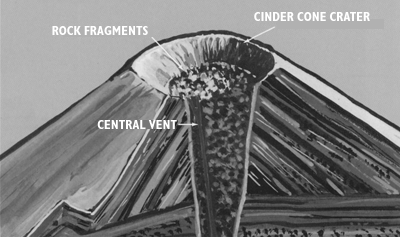
Cinder cones are small volcanoes with steep sides, made of tephra and volcanic bombs ejected from a clear central vent. Cinders themselves are composed primarily of mafic lava with more volatile gases than average. Cinders are smaller pieces of tephra, or molten rock, that will erupt with lava from the volcano and rapidly cool and solidify in the air. Larger tephra rocks (over 2.5 inches) are called volcanic bombs, which are potentially deadly to anyone within range.
Cinder cone volcanoes do not last relatively long, but they are common in the United States and Mexico. Because they are usually mafic in composition, they produce extrusive igneous rock deposits such as scoria.
Lava Domes

Lava Domes are fairly small structures made of felsic rocks that form within the collapsed craters of stratovolcanoes. These domes are made of extrusive rocks such as rhyolite, pumice, and obsidian that are piled around the vent. The dome-like structure is the result of the high-viscosity of the felsic to intermediate lava, which is too sticky to move long distances.
Lava domes have appeared in Mount St. Helens, Mammoth Mountain in California, and Chaiten in Chile (see above image).
Stratovolcanoes
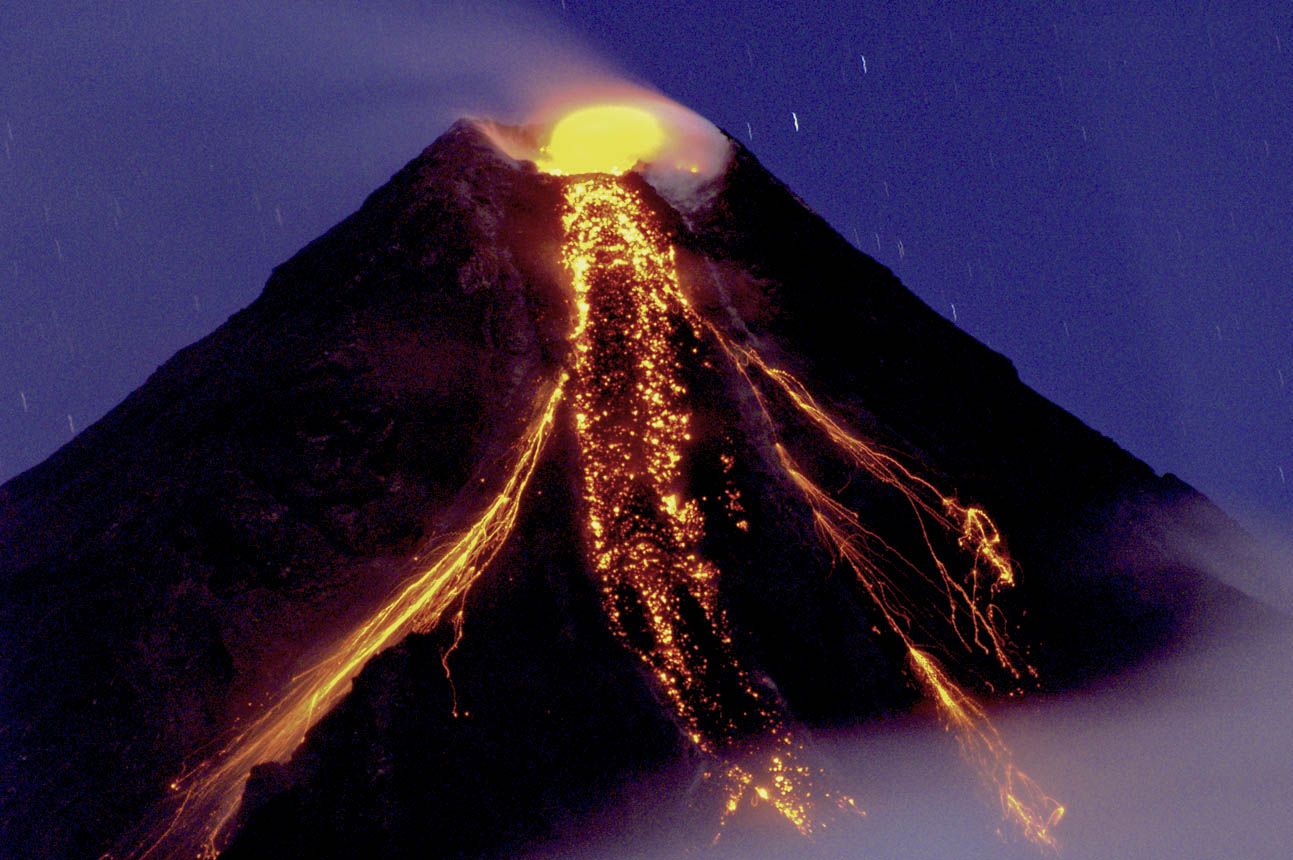
Mount St. Helens, Mount Vesuvius, Mount Fuji, Mount Pinatubo, Krakatoa—all of these infamous volcanoes belong to a frightening class of volcanoes that are historically known for their destruction and hazards. Stratovolcanoes (also called composite volcanoes) have steep sides and a symmetrical cone shape with an easily identifiable crater on top. These are called “composite” or “strato” because of the different layers of volcanic materials (such as ash) and lava that build up the volcano [1].
Stratovolcanoes can have magma that is anywhere from felsic to mafic in composition, although most of these volcanoes tend to be intermediate in composition. Stratovolcanoes usually form along subduction zones between oceanic-oceanic or continental-oceanic lithosphere. A good example of these volcanoes can be found along the Pacific Northwest. There, an ancient subduction zone used to exist between the North American plate and Farallon plate which formed the Cascade Mountain range and deadly stratovolcanoes including Mount Rainier and Mount St Helens. Check out the interactive model of Mt St Helens, below
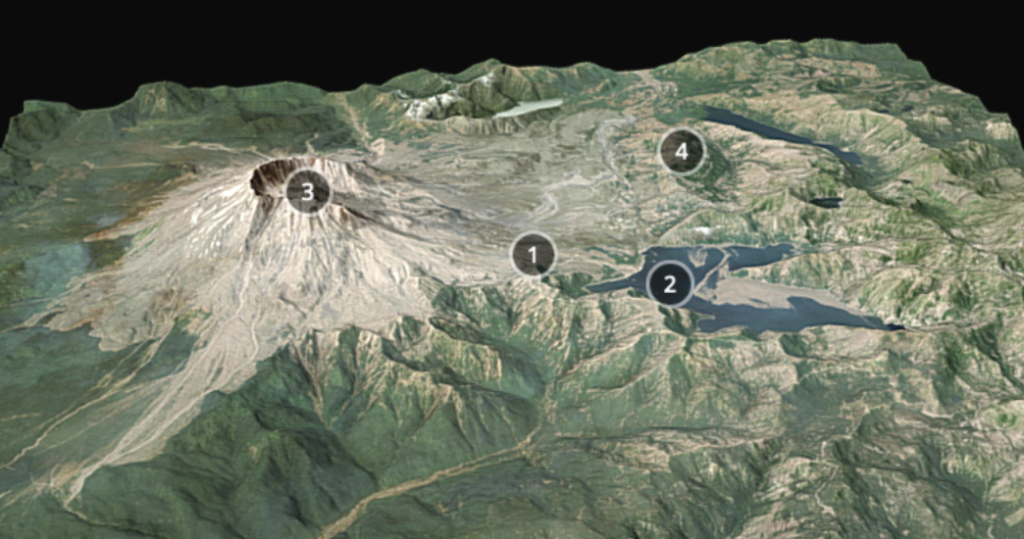
Shield Volcanoes
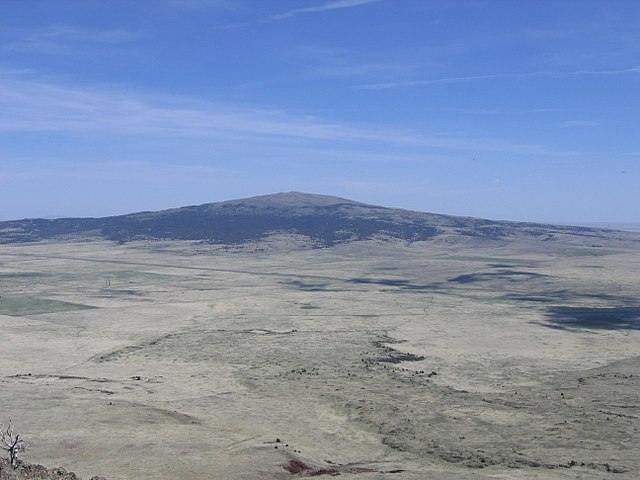
The largest type of volcano is a shield volcano. These are characterized by very broad, shallow slopes, and small vents. The word “shield” refers to the shield-like shape of the volcano when it is viewed from the side. Shield volcanoes are sourced from low-viscosity mafic magma, and they typically have basaltic lava that has reached far distances along the volcanic slope. We typically observe shield volcanoes in areas where the upper mantle rises to meet the crust. These areas include hot spots, mid-ocean ridges, and continental rift zones.

The mafic magma below shield volcanoes does not contain too many volatile gases; therefore, when shield volcanoes erupt, they are not very explosive. Instead, these volcanic eruptions are fairly small and predictable, which makes them less of a potential hazard than others. A perfect example of shield volcanoes can be found with the Hawaiian Islands at Mauna Loa and Kilauea (right). Click here to view an interactive model of Mauna Loa, the world’s largest shield volcano!
Kilauea is the most active volcano in the world, although it does not cause many human fatalities. The eruption of Kilauea from fissures in Hawaii in 2018, however, produced lavas that did considerable damage to roads and structures [1].
BACKYARD GEOLOGY: HOUSE MOUNTAIN, SEDONA
Sedona, AZ is not just a resort town with rust-red rocks! About 15 million years ago, this region was volcanically active due to the migrating continental hot spot, which is responsible for the San Francisco Volcanic Field. This hot spot produced both mafic magmas and lavas and near Sedona, a large shield volcano formed that we now call “House Mountain”. House mountain is pretty huge! This large shield volcano covers the area around 84 smaller volcano vents in an area of 180 square miles. While that is still much smaller than Mauna Loa (2,035 square miles!), that is still a pretty huge volcano [2]!
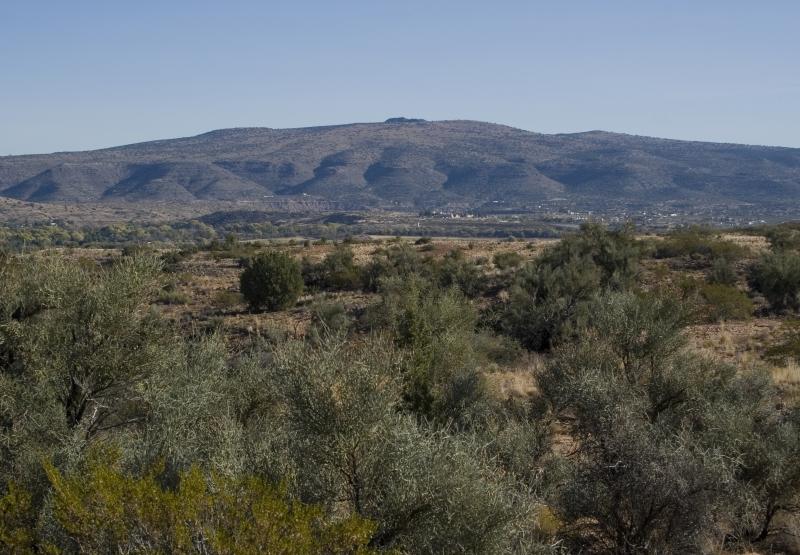
Calderas

Calderas are large (up to 15 miles in diameter!), crater-like depressions that form after a volcano has collapsed after it has emptied much of its magma chamber. It takes a very explosive eruption to eventually form a caldera, so it should come as no surprise that most calderas are found at volcanoes with highly viscous felsic and intermediate magma.
Because the caldera is a basin or depression, it often is filled-in by water to become a crater-lake. The Yellowstone Caldera and Crater Lake, Oregon (above) is a notable example of this type of volcano. In the figure below, you can see a diagram of how a caldera forms at Crater Lake from the Mount Mazama stratovolcano [1]. This volcano has an explosive eruption that drains the magma chamber, and causes a collapse of the vent. That collapsed feature then fills with water.
Flood Basalts
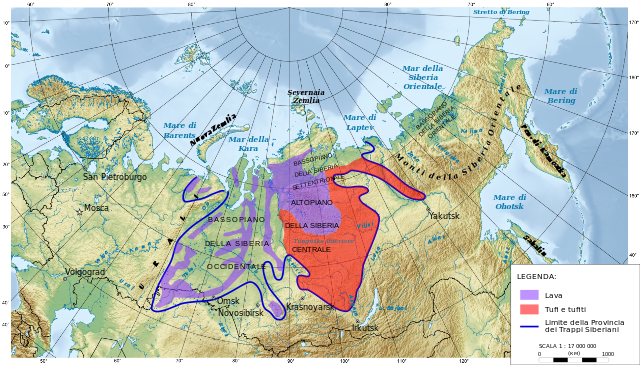
Flood basalts are a very uncommon type of eruption, but they are by far the largest and longest. As the name suggests, Flood Basalts are large-scale eruptions of basaltic lava. We have not seen flood basalts throughout human history, but the evidence of flood basalt activity has been found in the geologic record. We currently estimate that once volcanism begins, flood basalts will erupt for up to 1-3 million years!
Some notable examples of flood basalts include the Deccan Traps that cover about one-third of India and the Siberian Traps, which can be found in Russia. We now think that flood basalt volcanism can be a key contributor in causing mass extinctions in our planet’s history. For instance, the Siberian Traps, which were active about 252 million years ago, may have expelled greenhouse gases into the atmosphere in such large amounts that the entire planet’s temperature could have rapidly increased by 5°C!
This process of rapid warming in combination with other factors may have caused the largest mass extinction the world ever experienced, the Permian-Triassic Mass Extinction.
Super Volcanoes
“Super-volcanic” eruptions have the ability to impact the entire planet, and the life inhabiting it, for years. The eruption can exceed 100,000 atomic bombs! For those lucky enough to survive the initial blast, massive amount of ash is also ejected into the atmosphere and will blanket land hundreds of kilometers away. The combination of toxic gases and ash will furthermore block out sunlight in the atmosphere and cause “volcanic winters” that last for years. Such devastating eruption have not yet occurred in modern human society…yet.
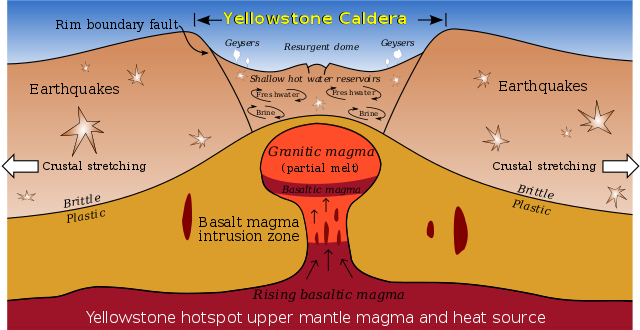
The Yellowstone Hot Spot is an active caldera-type volcano that is capable of a super-volcanic eruption. Although this is a hot spot volcano, it is very different from the shield volcanoes of Hawaii! This is because Yellowstone is located on the continental plate of North America. This very thick plate produces felsic to intermediate magma, which will erupt very violently.
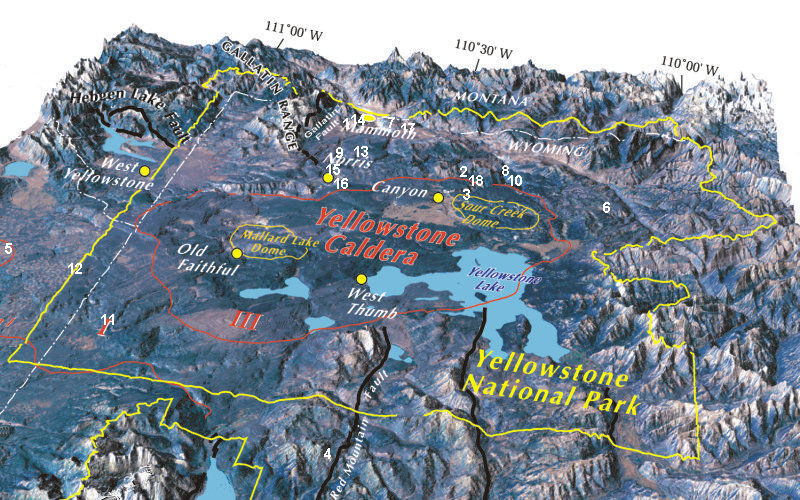
The Yellowstone caldera already erupted three times in the recent past: at 2.1, 1.3, and 0.64 million years ago [1]. Each eruption created large rhyolite lava flows and pyroclastic clouds of ash that solidified into tuff. These extra-large eruptions rapidly emptied the magma chamber causing the roof to collapse and form a caldera. Three calderas are still preserved from these eruptions, and most of the roads and hotels of Yellowstone National Park are located within the caldera [1].
an area on the Earth's surface where lava, ash, and/or volatile gases erupt and eventually solidify into rock.
molten rock that can be found beneath the Earth's surface.
originating from a feldspar and silica-rich magma/lava composition.
Originating from an iron and magnesium-rich magma/lava composition.
The thin, outermost layer of Earth composed of rigid rock, which is home to all known life on the planet.
Gases dissolved within magma or lava.
molten rock that has erupted at the Earth's surface due to volcanic processes.
A small type of volcano that is cone-shaped, steep, and built from mafic ash cinders and large volcanic rocks.
ejected rock and particle fragments from volcanic eruptions.
A hazardous molten rock ejected by volcanic eruptions that is at least more than 2.5 inches in diameter.
Fine-grained, or microcrystalline, igneous rock texture.
A mafic, vesicular igneous rock. Scoria is dark-colored, extrusive, and contains many cavities. However, it cannot float on water.
A round, hill-like protrusion formed by oozing, viscous lava found atop of a volcano.
A tall and steep conically-shaped volcano built upon past layers of hardened ash and lava flows. Also known as a composite volcano.
A felsic, extrusive igneous rock that is light-colored. Rhyolite forms by volcanic lava flows and it is light-colored.
A vesicular, extrusive igneous rock that is felsic. Pumice is light-colored and low density, and it often floats atop water.
A felsic, extremely smooth, fine-grained igneous rock that is glassy in texture. Obsidian is primarily composed of amorphous silica and displays conchoidal fracture.
a liquid's resistance to flow or movement
A composition of igneous rocks, magma, and lava that is between felsic and mafic.
an extreme natural event that is a threat to life and property
The process in which the older, denser tectonic plate at a convergent boundary will buckle and sink into the lithosphere. This plate will always be composed of oceanic lithosphere.
The outer, relatively rigid layer of the Earth that is composed of crust and upper mantle.
A large type of volcano characterized by broad, shallow slopes formed by low-viscosity mafic lava flows.
an igneous rock that is mafic and fine-grained. Basalt is dark and makes up the majority of the oceanic crust.
The outermost layer of the Earth's mantle, which contains both the lower lithosphere and upper asthenosphere. This layer is susceptible to convection currents and plastic flow.
A type of volcanic activity, that occurs independent of plate boundaries, in which a plume of molten magma from deep within the mantle upwells at the Earths surface.
(sometimes abbreviated as "MORs" by scientists) an underwater mountain ridge in the middle of the ocean that is formed by seafloor spreading centers at divergent boundaries.
an area on a continent where there is an active divergent boundary stretching and tearing the landmass apart.
A rounded, crater depression that forms at a volcano following a violent or explosive eruption that is often filled in by a lake.
A fluid (such as lava or magma) that is highly resistant to flow or movement due mostly to composition.
Large-scale eruptions of mafic lava that can last for millions of years. Flood basalts have the capability to significantly change global climate and possibly cause mass extinctions.
Earth's history as recorded by rocks deposited on and within its crust.
An event in which there is a sudden and widespread termination of species resulting in decreased biodiversity on the planet.
The world's greatest Mass Extinction event that occurred around 252 million years ago and resulted in the loss of 95% of ocean life and 70% of life on land.
consisting of the debris from a volcanic explosion such as ash, glass, and rock fragments. Refers to igneous rock texture or unconsolidated materials.
An igneous rock composed of the accumulated products of a volcanic eruption, such as ash, glass, lava, and debris. Tuff has a pyroclastic texture.

